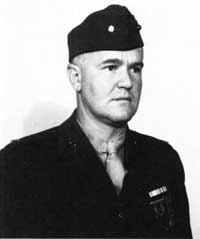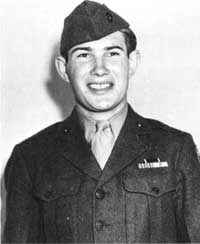|
BREAKING THE OUTER RING: Marine Landings in the Marshall Islands
by Captain John C. Chapin, USMCR (Ret)
The Army Attack: Kwajalein
In accordance with the overall campaign plan for the
seizure of the Marshall Islands, the Army's attack on Kwajalein Island
at the south end of the atoll began in exact synchronization with the
Marine assault in the north. The same softening-up process was used on
D-day, 31 January, with a large force of warships and planes pouring on
a blanket of high explosive. The Navy, for instance, fired 7,000 shells.
Because of the location of the islets immediately surrounding its main
objective, the 7th Infantry Division was able to follow a plan identical
to the Marines, with the 17th Infantry Regiment clearing the way for
placement of close-by supporting artillery. The 145th Field Artillery
Battalion then proceeded to inundate the target with 28,000 rounds.
Then, on D plus 1, the riflemen of the 32d and 184th
Infantry Regiments landed on Kwajalein Island itself. Because of
previous joint rehearsals held in Hawaii the amtracs carried in the
assault troops with smoothness and efficiency. In addition, Major
General Charles H. Corlett, the division commander, had an assemblage of
DUKWs (amphibious trucks always called "ducks") available, and it proved
valuable in ferrying priority supplies ashore to the fighting men.

|
|
Using palm fronds for concealment, two Marines carefully
scout out the terrain ahead of them on Roi in a firefight with the
Japanese forward of their position. Department of Defense Photo (USMC)
71920
|

|
|
A
rifleman of the 23d Marines moves slowly past a Japanese airplane and a
hangar destroyed on Roi by naval gunfire. The rifle slung over his
shoulder and the adjacent Marine carrying supplies indicate that combat
is no longer imminent. National Archives Photo 127-GW-1253-70345
|
Once ashore, the assault units found widespread
devastation from the preinvasion bombing and shelling. Smashed seawalls,
uprooted trees, demolished buildings, scarred pillboxes were everywhere.
Dug in amidst all this debris, the Japanese fought resolutely. This kind
of close combat usually forced the issue down to the individual level.
An Army officer, Lieutenant Colonel S. L. A. Marshall, who later
interviewed the troops, gave this account of how they dealt with the
deadly Japanese "spider holes" they encountered:
The holes were everywhere. Each one had to be
searched from close up. Every spot where a man might be hiding had to be
stabbed out. So greatly was the beach littered with broken foliage that
it was like looking through a haystack for a few poisoned needles . . .
.
The fire which cut the men down came from the spider
holes farther up the line. It was the kind of bitter going that made it
necessary for the junior leaders to prod their men constantly. The
leader of the 3d Squad had been trying to get his men forward against
the fire. Private First Class John Treager got up, rushed forward about
ten yards, hit the dirt, fired a few shots with his BAR [Browning
Automatic Rifle] and crumpled with a bullet in his head.
Somewhat farther along, a bayonet was seen sticking
up through a patch of fronds. The Jap crouched within it hadn't room to
draw in the whole length of the weapon. Private First Class Edward Fiske
fired his BAR at the hole; the dried fronds caught fire from the
tracers. At that point Fiske ran out of ammunition.
Private First Class Julian Guterrez then took up the
fire with his M1 [rifle]. He stood directly above the hole and fired
down into it. Then the hole exploded; the Jap inside had turned a
grenade on himself. A man's shattered arm came flying out of the hole
and hit Guterrez on the shoulder, splattering blood all over his face
and clothing. The arm bounced off and fell to the side. As Guterrez
looked at it, fascinated and horror-stricken, he saw another bayonet
rising out of a patch of fronds just beyond the outstretched and
still-quivering fingers. He yelled to a man behind him. The man relayed
a grenade and Guterrez pitched it with all of his might into the patch
of fronds. It erupted in a shower of palm leaves and blood and
flesh.
Guterrez reeled over toward the lagoon to cleanse
himself of the blood. Before he could reach the water, in sight of all
the other men, he vomited all over the beach. Minutes passed before he
could gather himself together again.
As the two Army regiments began their third day of
combat, it was dirty and dangerous work. One Marine historical summary
of the Marshalls operation told their story:
Resistance during the day was continually stiffer as
the enemy took advantage of every possible uncertainty of the terrain,
and concentrated the fire of such mortars and artillery as were left to
them. Despite the havoc wrought by the bombardments, there was still
much cover available and positions were concealed with great adroitness.
Many of the concrete installations still stood in partial ruin even
though they had received direct hits from heavy naval guns, and the fire
from 75mm [cannon] had little effect on them.
It was necessary to employ heavy demolition charges
to breach emplacements sufficiently for the employment of flame throwers
and grenades. In the utter turmoil, it was nearly impossible to maintain
contact. Nothing was any longer recognizable. The situation was made
doubly uncertain from the fact that fire might come from almost any
direction at the flanks, frontally, or from the rear. The going was
tough.

|
|
The
American flag is raised on Roi on 2 February 1944 to signify the end of
the fighting. In the background is the shattered hulk of a three-story
concrete blockhouse. Department of Defense Photo (USMC) 70650
|
Weird things can and do happen in such fighting. A
Japanese officer charged a U.S. tank with just his bare saber. In the
dusk one evening Japanese riflemen tried to walk into the American lines
carrying palm branches in front of their bodies so they would not be
seen. A U.S. infantryman carrying a flamethrower approached a pillbox,
and out through its door bolted a Japanese officer in counterattack. He
was squirting a fire extinguisher towards the flame gun. The liquid
doused the American soldier as he let the flame go. The Japanese officer
dropped dead at his feet, burned to a crisp.

|
|
Named "Dyess Field" in honor of the deceased battalion
commander who earned the Medal of Honor, the Roi airstrip was quickly
converted from Japanese use to become a new base for Marine aircraft as
the Central Pacific drive moved westward. National Archives Photo
127-N-88477
|
And so it went for four long days until the far tip
of Kwajalein had been reached and the island was declared secured.

|
|
Navy
corpsmen (in their Marine uniforms) are there on the front lines of
combat, plasma in hand, saving riflemen's lives in the critical minutes
after a wound. Department of Defense Photo (USMC) 72399
|
The successful battle for both ends of Kwajalein
Atoll had been concluded, and a series of conclusions were drawn from
it. Japanese deaths reached a total of 8,122, some 27 times the number
of Americans killed. The relatively small scale of U.S. casualties gave
Admiral Chester W. Nimitz the ready forces he needed to push forward
rapidly with plans for further action: first, one more atoll in the
Marshalls, and then quickly on to the vital Mariana Islands, the
linchpin of Japan's inner line of defense. Kwajalein would provide the
air base from which the B-29 bombers would conduct their raids on the
Marianas, and the Army 7th Infantry Division and the 4th Marine Division
would play key roles in those future operations.

|
|
LtCol Aquilla J. Dyess was posthumously awarded the
Medal of Honor for his heroic personal leadership on Namur. Known
affectionately as "Big Red," he was the only person to have been awarded
both the Medal of Honor and the Carnegie Medal for Heroism (in 1928). He
was honored in 1945 by having a Navy destroyer named after him.
Department of
Defense Photo (USMC) 36034
|
|

|
|
1stLt John V. Power, after being seriously wounded
attacking one pillbox, held his hand over his wound and went on to
attack a second one. He was posthumously awarded the Medal of
Honor. Department of Defense Photo (USMC) 307689
|
|
Tactically, there were a variety of innovations in
the twin battles at Kwajalein, and these would continue to prove
valuable in the future. There was the first use of Navy underwater
demolition teams; the first use of DUKWs in combat; the first use of
command ships with special communications equipment to control the
battle; the first use of airplanes to control naval gunfire; and the
first use of armored amphibian tractors (LVTAs). In addition, the two
battles saw the debut of new units designed to facilitate crucial
communications during combat. These were the Joint Assault Signal
Companies. The official Marine history of the Marshalls campaign
described their complex responsibilities:
The primary mission of this unit was to coordinate
all supporting fires available to a Marine division during an amphibious
operation. In order to carry out this function, the company was divided
into Shore and Beach Party Communications Teams, Air Liaison Parties,
and Shore Fire Control Parties . . . . During training, the various
teams were attached to the regiments and battalions of the division.
Thus each assault battalion could become familiar with its shore and
beach party, air liaison, and fire control teams.
Another new element was the way rockets were used.
This was a centuries-old technique of bombardment, but in the Marshalls
the 4th Marine Division was the first American division to use rockets
mounted on jeeps, pick-up trucks, and Navy gunboats in combat.

|
|
PFC
Richard B. Anderson was posthumously awarded the Medal of Honor for
sacrificing his life when he threw himself upon a live Japanese hand
grenade, in order to protect his fellow Marines. Department of Defense
Photo (USMC) 302952
|
|

|
|
Pvt
Richard K. Sorenson saved the lives of five Marines by throwing himself
on a Japanese grenade which was thrown in to the shell crater they
occupied. He was awarded the Medal of Honor and later recovered from his
terrible wounds. Marine Corps Historical Collection
|
|
One other Marine resource was unique: the use of
Navajo Indian "code talkers" in battle. They proved a perfect foil for
the Japanese ability in previous battles to understand Marine
voice-to-voice communications and Morse Code. To prevent this a group of
Navajo Indians had been recruited and trained in special code words they
could use in combat. When they were talking in the Navajo's exotic
language, no Japanese would ever decipher the message! At Roi-Namur
their walkie-talkie portable radios carried the urgent instructions back
and forth between ship and shore, as well as between higher echelons and
subordinate units, and did it so quickly that previous delays of up to
12 hours (intercepting, transmitting, and deciphering messages) were
eliminated.
Finally, the two battles for Kwajalein Atoll proved
incontestably the effectiveness of prolonged and massive preinvasion
naval gunfire and aerial bombing. The U.S. planes and warships had so
thoroughly scoured not only the target islands, but also the other
Japanese air bases in the Marshalls, that not a single Japanese plane
was able to attack the American surface forces in the campaign.
|











